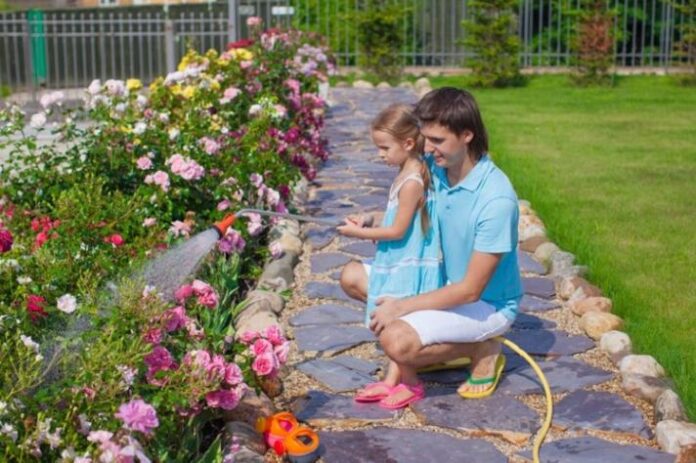Have you ever dreamed of having a stunning garden that doesn’t require endless hours of maintenance? A low-maintenance garden is the perfect solution for busy gardeners who want to enjoy a beautiful outdoor space without the hassle. In this article, we’ll share tips and tricks for creating a low-maintenance garden that will thrive with minimal effort. Get ready to transform your yard into a gorgeous, easy-to-care-for oasis!
Key Takeaways
- Choose the right low-maintenance plants for your garden
- Design your garden with simplicity and efficiency in mind
- Implement strategies like mulching and drip irrigation to reduce maintenance
- Enjoy more time relaxing in your beautiful, low-effort garden
Understanding Low-Maintenance Gardens
What is a Low-Maintenance Garden?
A low-maintenance garden is designed to require minimal time and effort to keep it looking great. It’s all about working smarter, not harder. The key is choosing the right plants and creating a thoughtful layout that minimizes upkeep. With some strategic planning, you can have a garden that practically takes care of itself!
Low-maintenance doesn’t mean no-maintenance though. Even the most self-sufficient garden will need occasional watering, weeding, and pruning. But by selecting plants that are well-suited to your climate and soil, you can drastically reduce the work required. Opt for hardy, drought-tolerant varieties that don’t need constant babying.
Benefits of Low-Maintenance Gardens
Why should you consider creating a low-maintenance garden? Here are some of the top benefits:
- Save time – Spend less time on tedious garden chores and more time enjoying your outdoor oasis.
- Conserve water – Drought-tolerant plants require less frequent watering, which is good for the environment and your water bill.
- Reduce fertilizer usage – Hardy, low-maintenance plants often need less fertilizing to thrive compared to fussier varieties.
- Increase property value – A beautiful, well-designed garden is a major selling point that can boost your home’s curb appeal.
With a low-maintenance approach, you can have the garden of your dreams without sacrificing all your free time. It’s a win-win!
Choosing the Right Plants
Low-Maintenance Plants
The foundation of any low-maintenance garden is selecting the right plants. Look for varieties that are known for being tough, adaptable, and easy to grow. Some top low-maintenance picks include:
- Perennials – These plants come back year after year, so you don’t have to replant them each spring. Coneflowers, black-eyed Susans, and sedum are all hardy, low-fuss options.
- Shrubs – Flowering shrubs like hydrangeas, lilacs, and viburnum provide structure and color with minimal upkeep. Evergreen shrubs offer year-round interest.
- Ground covers – These low-growing plants are great for filling in spaces between larger plants and suppressing weeds. Try creeping thyme, vinca, or pachysandra.
When choosing plants, consider their mature size to avoid constant pruning. Also, group plants with similar needs together to simplify watering and fertilizing.
Native Plants
One of the best ways to create a low-maintenance garden is by incorporating native plants. These are species that naturally grow in your area, so they’re already adapted to the local climate and soil. Native plants typically require less water, fertilizer, and pest control compared to non-native varieties.
To find native plants for your region, check with your local cooperative extension office or native plant society. They can recommend species that will thrive in your garden with minimal fuss.
Drought-Tolerant Plants
In many areas, water conservation is a top priority. Drought-tolerant plants are a smart choice for low-maintenance gardens because they can handle periods of dryness without skipping a beat. Some great options include:
- Lavender
- Rosemary
- Sage
- Yucca
- Agave
- Sedum
These tough plants have adaptations like fleshy leaves or deep taproots that allow them to store water and withstand drought. By choosing water-wise plants, you can have a beautiful garden that requires less irrigation.
Designing Your Low-Maintenance Garden
Garden Design Tips
Creating a low-maintenance garden starts with smart design choices. Here are some tips to keep in mind:
- Keep it simple – Opt for a clean, uncluttered layout with well-defined beds and paths. Avoid overly complex designs that will be harder to maintain.
- Create accessible paths – Make sure you can easily reach all parts of your garden for watering and upkeep. Wide, level paths made of materials like gravel or pavers are a good choice.
- Group plants wisely – Place plants with similar needs together to make watering and fertilizing more efficient. Consider creating specific zones for different types of plants.
- Incorporate hardscaping – Non-plant features like rocks, boulders, and sculptures add interest to your garden without requiring maintenance.
By keeping your design streamlined and functional, you’ll set yourself up for low-maintenance success.
Mulching and Composting
Mulch is a low-maintenance gardener’s best friend. A thick layer of organic mulch like shredded bark or straw helps retain moisture, suppress weeds, and regulate soil temperature. It also breaks down over time, adding nutrients to the soil. Aim for a depth of 2-3 inches around your plants, but avoid piling it against stems or trunks.
Compost is another great addition to a low-maintenance garden. It improves soil structure, drainage, and fertility. You can make your own compost at home using kitchen scraps and yard waste, or purchase it from a garden center. Incorporate a layer of compost into your soil each spring to give your plants a nutrient boost.
| Mulch Type | Pros | Cons |
|---|---|---|
| Shredded bark | Long-lasting, attractive | Can be expensive |
| Straw | Inexpensive, breaks down quickly | Can introduce weed seeds |
| Pine needles | Good for acid-loving plants | Can be hard to find |
| Grass clippings | Free, readily available | Decomposes rapidly |
Irrigation Systems
Hand watering can be time-consuming, especially in larger gardens. Installing an irrigation system is a smart way to streamline your watering routine. Options include:
- Drip irrigation – This system uses flexible tubing with small emitters to deliver water directly to plant roots. It’s efficient and minimizes evaporation.
- Soaker hoses – These porous hoses seep water along their entire length, providing a slow, deep soak.
- Sprinklers – Overhead sprinklers are good for lawns and large areas, but they can be less efficient than targeted watering methods.
With an automated irrigation system, you can ensure your plants get the water they need without having to drag out the hose every day. Just be sure to adjust your watering schedule based on rainfall and seasonal changes.
Maintaining Your Low-Maintenance Garden
Pruning and Trimming
Even low-maintenance gardens need occasional pruning and trimming to look their best. The key is to choose plants that don’t require frequent shearing and to prune at the right times. Here are some tips:
- Prune flowering shrubs immediately after they bloom
- Cut back perennials in late fall or early spring
- Remove dead, damaged, or diseased branches anytime
- Avoid over-pruning, which can stimulate excessive growth
When pruning, always use clean, sharp tools to avoid damaging your plants. Make cuts at a 45-degree angle just above a leaf node or bud.
Watering and Fertilizing
While low-maintenance gardens require less watering and fertilizing than high-maintenance ones, they still need some attention. Deep, infrequent watering is better than shallow, frequent irrigation. Aim to water deeply enough to moisten the entire root zone, then let the soil dry out slightly before watering again.
When it comes to fertilizing, less is often more. Over-fertilizing can lead to excessive growth that requires more maintenance. Stick to a slow-release, organic fertilizer applied once or twice per year. You can also top-dress your soil with compost annually to provide a gentle nutrient boost.
Pest Control
No garden is completely immune to pests, but low-maintenance gardens are often less susceptible thanks to their tough, resilient plants. The best defense against pests is a healthy garden with robust plants that can withstand some damage.
If you do notice pest problems, try these low-maintenance control strategies:
- Remove infected plant parts and dispose of them away from your garden
- Use physical barriers like row covers or netting to exclude pests
- Encourage beneficial insects like ladybugs and lacewings, which prey on common garden pests
- Apply organic pesticides like neem oil or insecticidal soap as a last resort
By keeping a close eye on your plants and addressing pest issues early, you can often avoid major infestations that require more intensive treatment.
Conclusion
Creating a low-maintenance garden is all about working with nature, not against it. By choosing the right plants, designing with simplicity in mind, and using smart strategies like mulching and irrigation, you can enjoy a beautiful outdoor space that practically takes care of itself.
Remember, low-maintenance gardening is a journey, not a destination. It may take some trial and error to find the right combination of plants and practices that work for your unique space. But with a little patience and persistence, you can create a gorgeous garden that gives you more time to relax and enjoy the fruits of your labor.
So what are you waiting for? Get out there and start creating the low-maintenance garden of your dreams! With these tips and tricks up your sleeve, you’ll be well on your way to a stunning yard that’s easy to maintain and a joy to behold. Happy gardening!








